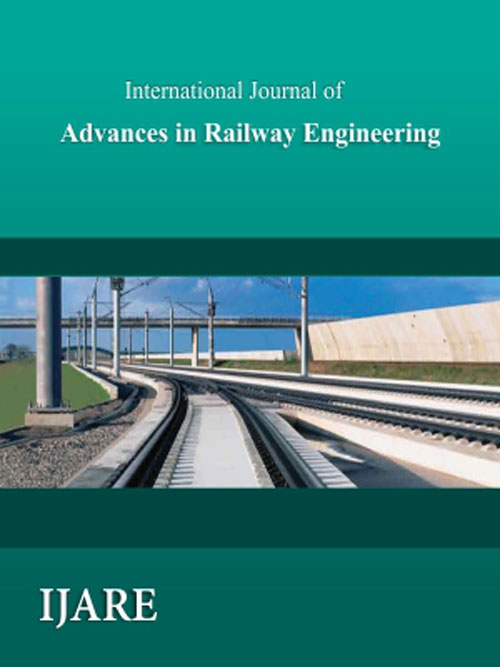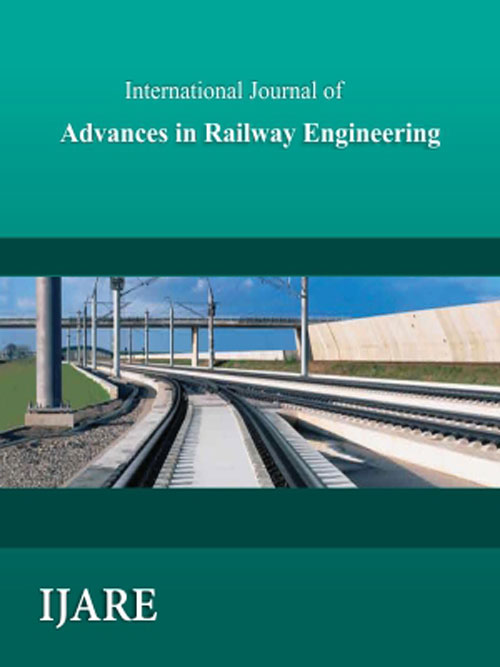فهرست مطالب

International Journal of Advances in Railway Engineering
Volume:2 Issue: 2, Summer - Autumn 2014
- تاریخ انتشار: 1395/01/20
- تعداد عناوین: 6
-
-
Pages 73-84The evaluation and control of the trains induced vibrations needs even more attention in the case of underground tracks which passes near to monuments and historical sites. The rail corrugations which occur due to the wheels impulse loads during the operation period of underground railway tracks, usually amplify the ground borne noise and vibration. In the current study, the mentioned phenomenon is simulated in Isfahan metro line 1 which includes twin tunnels and passes nearby of ChaharBagh School monument. In this matter, a three dimensional vehicle track interaction software (Adams/Rail) was used in conjunction with a geotechnical FEM software (Plaxis 2D). For this purpose, the vehicle-track interaction problem was solved considering rail corrugation in Adams/Rail part of MSC Adams® software and the amplified wheel load was imposed in a 2D plain strain model in Plaxis and consequently, the ground borne vibrations were extracted as vertical vibration velocity at a bench mark points (twin tunnel centerline and vicinity of Char-Bagh School) on the model surface. In this regard, sensitivity analyses were performed on train speed to show the corrugation effect on both increase in wheel dynamic impulse load and root mean square of vibration velocity at a bench mark points. The numerical results indicate that due to presence of rail surface corrugation, axle load increases with raise in train speed. In the worst case, when two trains run simultaneously with 90 Km/hr in twin tunnels, the maximum induced vibration at bench mark points are about 79.53 and 75.82 dB respectively.Keywords: Rail corrugation, train induced vibrations, Isfahan urban railway, historical monument
-
Pages 85-92Although, Single-Sided Linear Induction Motor (SLIM) utilization has increased in railway applications due to their numerous advantages in comparison to Rotational Induction Motors (RIM), there are some sophistication in their mathematical models and electrical drive. This paper focuses on the problems of SLIM modeling, with assuming end-effect on the basis of Field Oriented Control (FOC) as a drive control method. To do so, two dynamic models of SLIM are described and investigated. To evaluate their technical characteristics (i.e., thrust, torque, current, and speed) and also motor performance, a comparison is realized for synchronous and stationary reference frames in both dynamic models. Further, the disparities of these two dynamic models and FOC operation in the two reference frames are discussed. Finally, the validity of the control method accuracy is verified for each model by simulation results.Keywords: electrical railway, linear induction motor, dynamic model, field oriented control
-
Pages 93-106With speed increasing in high-speed trains, due to limitations of other types of brakes, aerodynamic brake has become an important braking method. In this task to make better use of brakes panel different configurations are examined and the best panel shape which provides the reasonable drag coefficient is introduced. The results of simulations are carried out with the computational fluid dynamic (CFD) software for a high speed train moving at speed of 360Km/hr. To provide the best arrangement of braking panel rows on the train roof, four cases are studied: a train without aerodynamic brakes, with one, two, and three rows of aerodynamic brakes panel over the roof of the train. The braking force per unit area of aerodynamic brakes is determined and compared with the results found in literature. With regard to the drag coefficient and necessary space for the placement of panels, the best shape and arrangement is introduced. Finally, to examine the material and thickness effects on operation of braking panels; stress and modal analysis have been performed and variation in: weight, maximum stress, displacement and first natural frequency are discussed.Keywords: braking panels, drag coefficient, high, speed train, natural frequency, CFD
-
Pages 107-111On the circular curve, lateral acceleration affects comfort. On the spiral, both lateral acceleration and jerk affect comfort. The determination of maximum curving speed on the basis of lateral acceleration only is not critical because the lateral acceleration is proportional to the square of speed whereas jerk is proportional to cubic power of speed. The maximum speed on a curve is thus significantly restricted by the spiral length. In this paper, spiral length is formulated on the basis of both lateral acceleration and jerk. The proposed formula is applied on curves of various curvature and validated against an earlier formula by the author. On the basis of current choice of values of lateral acceleration and jerk, a relation between jerk and lateral acceleration is given that can be used to determine the acceptable value of jerk for a given lateral acceleration. A single criterion is proposed to decide the requirement of a spiral curve.Keywords: spiral length, unbalanced superelevation, actual super, elevation, jerk, lateral acceleration
-
Pages 113-120Thorough understanding of steel rail response to wheel load is a key step towards design and evaluation of the railway track structure. In current practice, maximum vertical deflection and bending moment are calculated using the theory of infinite beam on continuous elastic foundation (Winkler model), in which the foundation stiffness is assumed as constant. However, variation of track modulus along the rail is an inherent feature of the railway track structure. Inevitable variation in local geology, layer properties, layer thickness and track construction procedure along the track disturb track support uniformity. Track modulus can also rapidly change over a short length of the track at transition zones or at the locations of local problems, such as hanging or broken ties. This study aims to investigate the effect of track modulus variation on rail bending response using finite element method. In the proposed dynamic track model, various track modulus distributions are considered and track response to a moving wheel load set is calculated using direct integration time history analysis. The envelope profile of the rail maximum vertical deflection and bending moment derived from finite element models are then compared with the corresponding Winkler model results.Keywords: Railway track structure, rail bending behavior, track modulus variation
-
Pages 121-126After 1860s the railway systems has started to be used in urban transportation in the world. However, especially after the 1950s, automobile usage has been increased quickly. Thus the dense of transportation has started to move from railway systems to the ones with rubber tire vehicles in Istanbul. Traffic density in urban transportation has started to be experienced since 1950 with the increase in the automobile usage and other rubber tire vehicles. The length of railway systems in Istanbul, which reached to 130 kilometers till the year of 1950, became null with a continuous decrease in 1966. However, the priority in the developed countries in the same period of time was given to the mass transportation systems, specifically to the railway ones, that were more comfortable, more secure and more economic (Ocak and Manisali,2006).Keywords: Railway systems, tramway, passenger information system, communication protocol


